Volvo used be the go-to brand for safe vehicles that lasted a long time. Then everyone else began making “safe” vehicles, chiefly because the government was mandating that.
Other-brand vehicles also became as or even more reliable than Volvos used to be, too.
Now Volvo is making electric vehicles like the 2024 XC40 Recharge – and hoping people will get a charge out of them.
The XC40 Recharge is a compact-sized, five-passenger electric crossover based on the XC40 – which still has an engine (paired up with a mild-hybrid system).
It’s more expensive – $52,450 to start for the base Core trim with a single electric motor and rear-wheel-drive vs. $40,100 for the base B5 Core trim XC40 with all-wheel-drive.
And it doesn’t go as far on a charge (293 miles of range is standard) as the mild-hybrid XC40 can go on a tank (340 miles in city driving, 426 on the highway).
But you might get a charge out of not having to get gas again.
And from the acceleration that you can get from the dual-motor version of the XC40 Recharge, which offers 402 horsepower – vs. the regular XC40’s maximum of 247 horsepower.
You also might get a charge out of the fact that Volvo doesn’t ask much more money for all that additional horsepower. You can pick up a dual motor version of the XC40 Recharge for $54,200 to start. That’s only $1,750 more than the MSRP of the base Core trim with the single motor set-up.
A top-of-the-line Ultimate with the dual motor drivetrain and an efficiency-augmenting heat-pump (rather than electric hot-wire/baseboard style) cabin heating, 20 inch wheels, a premium Harmon Kardon audio system, crystal shifter knob and a panorama moonroof stickers for $60,550.
The price you pay for all that extra power is less range – 248 miles vs. 293. But if you don’t need to drive farther than 248 miles at a time, you might not miss not having the range to go farther than that.
Especially when you can go much faster.
What’s New For 2024
Volvo has added several trims and lowered the base price of the XC40 Recharge by $1,100 vs. last year – when the least expensive version of this electric crossover stickered for $53,550. However, the new-for-2024 lower-priced base trim no longer comes standard with the dual motor setup or the 402 horsepower that used to be standard.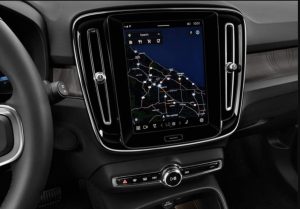
On the other hand, more range is now standard – for those who don’t need 402 horsepower.
What’s Good
A bit more cargo capacity (25 cubic feet) than the non-electric XC40 (20.4 cubic feet).
Costs less to start this year than last year.
Option to choose more power – or more range.
What’s Not So Good
Standard single-motor iteration doesn’t offer the impressive acceleration that is the main selling point EVs have vs. gas-engined vehicles.
Non-electric XC40 costs $12,350 less to start ($49,100) and comes standard with all-wheel-drive as well as about 100 more miles of driving range.
Maximum towing capacity even with the optional twin motor drivetrain is just 2,000 lbs. vs. 3,500 lbs. of standard towing capacity for the XC40 that doesn’t need to recharge.
Last year, the XC40 Recharge came only with the dual motor drivetrain (Volvo calls it “twin” motor) and – like most electric vehicles – it emphasized power and performance, which comes at the cost of range. Which was only 254 miles – and that’s even less than the figure indicates because using up most of any EV’s touted maximum range risks leaving you stranded by the side of the road waiting for a tow – because it’s hard to carry a can of volts back to an EV that ran out of charge. Or waiting for at least 20-30 minutes at a public “fast” charger before you can get back on the road again.
You can’t just stop and fill ‘er up – and be back on the road with a full tank in less than 5 minutes.
So unless you’re sure you’ll be able to charge up when you reach wherever you’re headed – and have time to wait for a charge because you don’t need to be anywhere else anytime soon – it’s necessary to leave charge in reserve. Probably at least 15-20 miles, to be safe.
Then you have to factor in the fact that whatever the range remaining indicator says may be less than the range you actually have left.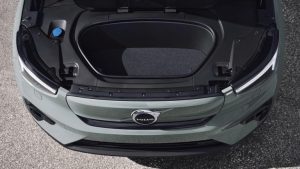
We’re used to fuel gauges that tell us how much gas (and so, how much driving range) we have, more or less. Fuel gauges are often not exactly accurate but they’re usually pretty close in that if it says you have a half-full tank, it’s probably very close to that. But EV range indicators are more complicated things that analyze various factors – such as how the vehicle has been driven, how hot or cold it is – to make a prediction about how much driving range there is remaining. As the system crunches it numbers, the prediction can change dramatically and in very little time. For example, you may see 180 miles of indicated range remaining when you first get in the vehicle – but after just a couple miles of actual driving, you glance at the display and discover you only have 160 miles of indicated range remaining.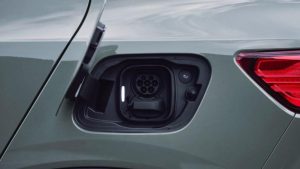
Last year’s XC40 Recharge – with the standard twin motor setup and 402 horsepower and the ability to get to 60 in about 4.5 seconds – had only had 223 miles of indicated, best-case range.
And less than that if you made use of all that power/performance.
This year, the twin motor version advertises a bit more range – 254 miles – and the same performance. And you can buy a new XC40 Recharge with a single motor that goes as far as 293 miles on a full charge. That’s not just 45 miles more driving range; it’s 45 miles more margin.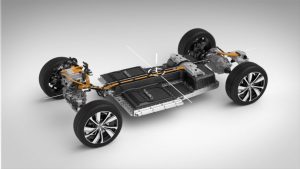
On the downside, the single-motor XC40 Recharge’s performance – in terms of how quickly it can get to 60 – is on par with that of the regular XC40 that comes standard with about the same power – 247 horses out of its turbocharged, 2.0 liter four cylinder engine vs. 248 for the single-motor Recharge – and you still have less range and a longer wait. The non-electric XC40 can take you 340 miles in city driving and 426 miles on the highway; it also only takes about three minutes to refill its 14 gallon gas tank – so it’s not a precarious thing to run it to nearly empty because you can get it full (and get back on the road again) in just minutes almost anywhere, almost anytime.
The other negative is that the XC40 Recharge is only rated to pull a maximum of 2,000 lbs. – even with the very powerful twin motor drivetrain – whereas the regular XC40 that doesn’t recharge comes standard with a 3,500 lb. max tow rating.
The new single-motor iteration of the XC40 Recharge sacrifices power/performance for the sake of increased driving range – which greatly increases its practicality as a vehicle. That is to say, as something you buy to drive – that gets you where you need to go and back again.
As opposed to something you buy to drive fast – which is fun but greatly decreases the practicality of the vehicle.
Put another way, the new single-motor iteration of the XC40 Recharge makes more sense than the previous iteration that came standard with much more power/performance at the cost of practicality.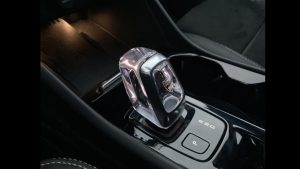
But that also has the downside of taking away what’s usually an electric vehicle’s most attractive selling point: Maybe it doesn’t go very far – and maybe I’ll have to spend a lot of time waiting for it to charge up. But it goes like stink when you push on the accelerator!
And that makes you feel better about the cost – including the time spent planning around and waiting for a recharge.
Well, now the cost of the wait – and the planning – has been reduced. But it no longer goes like stink when you push on the accelerator. It accelerates quietly and the immediate responsiveness of the torque-right-now electric motor – singular – is there. But it’s not the compress-your-spine acceleration of the twin-motor iteration of the XC40 Recharge. And it’s about half-a-second slower accelerating to 60 than the XC40 that doesn’t need to recharge: 6.9 seconds vs. 6.1 for the non-electric XC40.
So what are you getting for the extra $12,350 you spent – other than less range and longer waits?
This is the EV Conundrum.
Or at least, one of them.
If the XC40 Recharge cost about the same as the XC40 that doesn’t recharge, it’d be a very interesting and even compelling alternative to it. Silent drive, recharge at home (assuming you have the time and don’t mind the wait) but most of all, no paying for gas going forward. And if you were paying about the same for the Recharge and had the time to wait for it to charge up at home (where electricity is cheapest) then the purchase could be more than justified on economic grounds in that you’d probably end up saving a lot of money that you’d otherwise have spent on gas.
But when it costs $12,350 more and doesn’t go faster – or farther – than the XC40 that doesn’t recharge, it’s a harder sell.
The twin-motor iteration’s acceleration, on the other hand, can make you forget all about how far it doesn’t go – and feel good about what you’re paying extra for – every time you put your right foot down. 
At The Curb
The XC40 Recharge looks almost the same as the XC40 that doesn’t recharge. So how does one tell the difference?
Just look at the grill. Or rather, notice that the XC40 Recharge hasn’t got one – because it doesn’t need one. Because it doesn’t need air to flow over the cooling finds of a radiator. Because it hasn’t got an engine.
So – instead – there’s a body-colored filler panel.
There’s also a charge port, of course. And inside, some EV-specific instrumentation. But what you’re looking at here is a battery powered version of a vehicle that was originally an engine-powered vehicle that was converted to battery power. This is not by any means a bad thing in that it allows for meaningful vehicle vs. vehicle comparison, which is harder to do with something like a Tesla Model X or Y because both of those vehicles are not electrified versions of pre-existing engined vehicles.
Here, you can readily see what you get – and don’t – and how much it’s going to cost (or not).
One thing you do get – when you buy the Recharge is a little more cargo space: 25 cubic feet vs. 20.4 with the XC40 that does not recharge. Which is interesting given the Recharge has that big electric battery pack under its floorpans and that electric motor out back, also underneath the floorpans. It’s more usually the case that an EV – especially one converted from a pre-existing, non-electric vehicle – has less cargo room on account of the room taken up by the battery pack and motor(s).
The reason why the Recharge has that extra bit of cargo carrying capacity is because there’s space under the hood – where there isn’t an engine.
So that’s a plus.
One thing that’s a negative – for prestige-brand vehicle with a base price of more than $52k – is that a power front passenger seat is not standard – and to get it, you have to pony up $55k to get into the Plus trim. The reason why probably has to do with weight – and draw. Manual seats weigh a little less and they draw no power from the battery, which is always a concern with EVs given the range/recharge issues.
The top-of-the-line Ultimate gets a more efficient, home heat pump-style cabin heater, which uses less power to keep the cabin warm when it’s cold outside. But you have to spring for the Ultimate – which starts at almost $60k – to get this range-increasing (in the winter) feature.
The Rest
Most new vehicles require the driver to push a “start” button in order to start the engine – or turn on the power, in the case of an EV. Not in this case. The XC40 Recharge only requires that you carry the usual keyless ignition fob with you. What’s unusual is there is no “start” – or “power on” – button. The power just comes on. The vehicle is ready to drive as soon as you sit down. It’s an elaboration of the keyless entry system that automatically unlocks the doors when you approach the vehicle. Just pull the optional translucent crystal selector toggle on the center console backward to engage Drive – and off you go.
When you get where you’re headed, push the button for Park and the drivetrain powers off automatically. Get out, close the door and walk away; the Volvo powers everything else off until your return.
The Bottom Line
The increased range of the single motor version of this small electric crossover increases it appeal as a more practical electric vehicle. But its modest performance may make some buyers wonder what they’re paying $12,350 extra for – relative to the XC40 that doesn’t need to recharge.
. . .
If you like what you’ve found here please consider supporting EPautos.
We depend on you to keep the wheels turning!
Our donate button is here.
If you prefer not to use PayPal, our mailing address is:
EPautos
721 Hummingbird Lane SE
Copper Hill, VA 24079
PS: Get an EPautos magnet or sticker or coaster in return for a $20 or more one-time donation or a $10 or more monthly recurring donation. (Please be sure to tell us you want a magnet or sticker or coaster – and also, provide an address, so we know where to mail the thing!)
If you like items like the Baaaaaa! baseball cap pictured below, you can find that and more at the EPautos store!



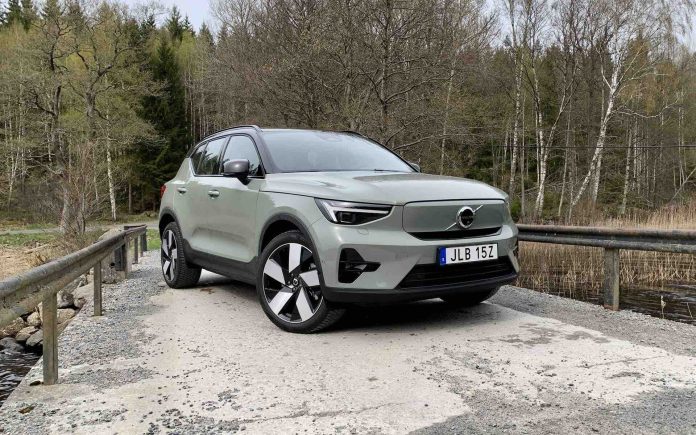

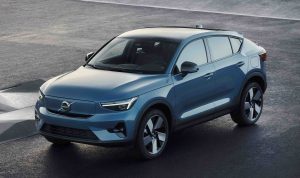
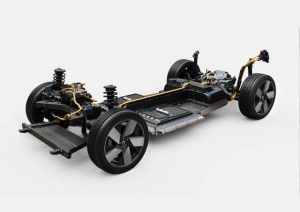








Latest one EVs: Huge fire, over 50 Rivian’s burned at their Normal Illinois plant. And Ford has lost 5 billon on EVs in 12 months, 44,000 dollars on each unit, and is reportedly switching th hybrids. Grow a brain eh? Free market consumer preference in action.
This is kind of sad. I was a Volvo guy for years and these new ones leave me cold.
And I agree about the straight line speed. Some of the funnest and best cars I’ve ever owned were also the slowest off the line. Is it surprising, though, that the greenies are all about drag?
Excellent review, regardless. Question: do they trailer the EVs to you?
Thanks, Yeti!
No, they don’t trailer them. But it is an ordeal getting them here. None can make the 220 mile trip from the press pool up in the DC area to my place without stopping – and waiting – for a charge at least once on the way. And then once more just before they get to my place, because they don’t drop them off not ready for me to drive (i.e., low on charge) because that would defeat the point of bringing them. So they stop – and wait – a second time. This adds at least an hour to what would otherwise be a less-than-four-hour drive for the delivery driver. And there are often unexpected hassles along the way, such as the “fast” charger they hoped to use not being available.
I still have the Volvo, which they are picking up tomorrow. I haven’t been able to drive it since I last did on Tuesday – because it takes 24-plus hours on 120V to get back more than about 40 miles of range.
Unreal. Thanks for the response. A pickup with a car hauler seems like it would be more practical.
One more question: how often do you have follow up conversations with the manufacturers’ flacks once you publish your reviews?
FFS Eric, you’re a professional auto reviewer, and you refuse to install a dryer outlet so you can plug in the newest vehicles? Look at it this way; you need it for your welder. It just happens to work on the new EV’s you have to review, so you can use it to better review the latest technology. Your attitude towards auto evolution is child-like. It’s not your car, you wouldn’t buy it ok bla bla bla we get it, but you’re only making yourself look foolish by only using 110 when you only have the car for a short period of time. P.S. You can pick up a portable charger online for about $120. You just plug it in and you’re good to go.
Hi No Offence,
The problem is that different EVs use different plugs and – no – I am not going to deal with or pay for multiple different receptacle types in my house. I have a welder outlet, by the way. But the receptacle fits my welder.
Not all the different plugs that different EVs have!
Did you know that it can cost upwards of $1,000 to upgrade a home panel to accommodate the needs of an additional dryer/stove-type outlet? Yet another additional cost of owning one of these things. In addition to the higher cost of insuring them, re-shoeing them (tires wear much faster due to the weight and the torque of the motors) and replacing them – or their battery packs.
My “child-like” attitude toward “automotive evolution”? Why is it that EV apologists always soft-shoe the pushing – the forcing – of EVs? Your verbiage implies a natural “evolution” of a superior alternative to what exists that’s organic and unforced. That I’m opposed to “progress.”
And that’s just false.
I would expect to get slapped for the child like comment. Some of us have personal preferences for a reason. I am old school and like a lot of old school things. It is not a matter of nostalgia but functionality. I am a service tech and work on primarily analog equipment. For some diagnosis I use an analog meter because I can see the needle fluctuations with out any read delay. I appreciate the latest technology and use it when appropriate.
Hi eatgruel,
The guy who called me that is typical of the EV cat-callers I get. They like to pretend that EVs just sort of happened... they do not want to deal with the fact that they have been literally pushed onto the “market” via enormous subsidies and rent-seeking scams (e.g., “carbon” credits) while at the same time, gas and diesel engines are being systematically regulated off the “market.” They accuse people like me – who point out the facts about the EVs – of being Luddites. It’s untrue and it’s absurd. I have said – over and over and over – that I like and support the idea of alternatives; that I think people have a right to buy what suits them and that if there is natural market demand for something, then the market will and ought to provide it. I think EVs can make sense for some people.
But I resent the way EVs are being pushed on people.
They accuse people like me – who point out the facts about the EVs – of being Luddites. It’s untrue and it’s absurd.
It’s especially absurd when we consider the fact that it is the EV proponents themselves who are Luddites. They want us to go back to using BEVs, a technology that was outcompeted and made obsolete a century ago (!) by the modern internal combustion engine-powered car. That’s quite an anti-progress stance.
[Eric’s] attitude towards auto evolution is child-like.
Auto evolution? What auto evolution? Had there been actual evolution, there would not have been any need for Eric or anyone else to charge the EV at home at all, it would have been sufficient to drive to a nearby fast charger and spend five minutes or less charging the onboard EV battery from 0-100 %. Due to the lack of evolution, even a basic task like this is impossible – fast chargers do not exist, since they have not even been invented yet, and Volvo, it seems, are simply too incompetent to address this fundamental problem.
So no point in blaming Eric here, blame the automakers instead.
The point keeps coming up with EVs – if you are going to pay more, what do you get for the extra money?
Doesn’t seem like anything worth the extra price.
“Standard single-motor iteration doesn’t offer the impressive acceleration that is the main selling point EVs have vs. gas-engined vehicles.”
In 44 years of driving, I can’t think of any instance where impressive acceleration was necessary.
All the rest is just more technocrap that’s more stuff to break, IMHO.
Hi Mike,
It’s sometimes nice (and always fun) to have a vehicle that jumps when you push down on the accelerator pedal. But – you’re right – it’s usually not necessary. That’s why impressive acceleration has – historically- been the main selling point of vehicles that are not necessary, such as high-performance cars. But EVs have had to tout performance – because they cannot tout economy/practicality. It’s a weird thing, when you think about it – given that EVs are being pushed on people as a necessity – to “save the planet.”
Well, if so, then why all this hoopla about how quick (and powerful) they are? Especially since those attributes reduce their economy and practicality.